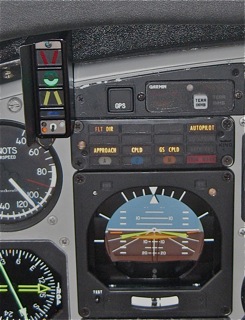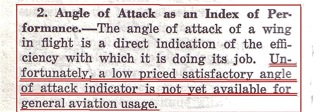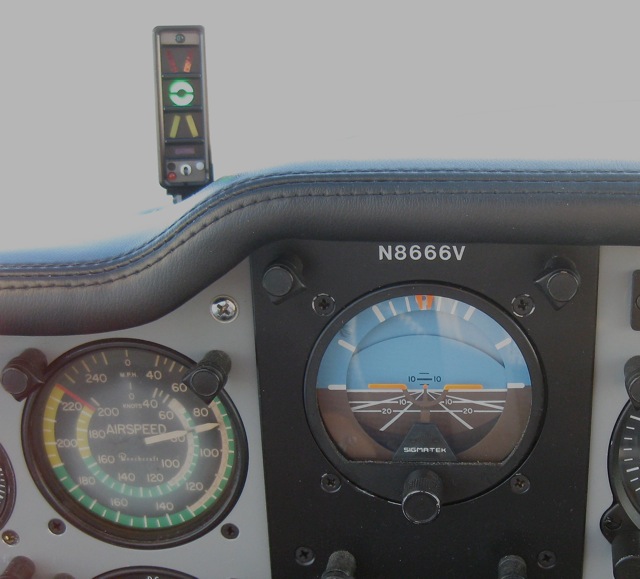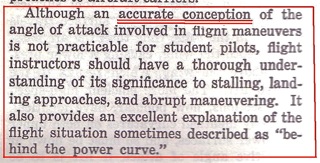All aviators know that Angle Of Attack (“Alpha”) at stall is NOT affected by variances in aircraft cabin or fuel loads, or by density altitude or by angle of bank,
Every aviator is taught and knows the critically important “ Angle of Bank v. G-Force” curve. But there is not a pilot flying who has the ability to compute his constantly-changing margin above stall (a Vref, or an Optimal Alpha Angle) especially when operating with varying loads in a bank on a hot muggy day at altitude. An Alpha-sensing system can do that easily and accurately in real-time. Operationally, Alpha is critically important; accordingly, most heavier aircraft have some sort of Alpha-sensing system on board. Angle of Bank v. G-Force” curve. But there is not a pilot flying who has the ability to compute his constantly-changing margin above stall (a Vref, or an Optimal Alpha Angle) especially when operating with varying loads in a bank on a hot muggy day at altitude. An Alpha-sensing system can do that easily and accurately in real-time. Operationally, Alpha is critically important; accordingly, most heavier aircraft have some sort of Alpha-sensing system on board.
Lighter general aviation aircraft have never really had a good AoA indicator available at a reasonable cost. Now, we do; an elegantly simple device that constantly computes and displays a safe airspeed buffer. This totally trustworthy observer is always watching one thing only: my margin above stall. (The "fast-half" of the green donut here shows this King Air to be about 35% above stall.)
The FAA has known the importance of Angle of Attack instrumentation for decades, but -- only recently -- low cost modern electronics have become available to do the job -- affordably -- in light aircraft. This was published by the FAA in 1964.
FAA Flight Instructor's Handbook - 1964

Clearly, the FAA would have enthusiastically encouraged installing AoA instrumentation in training aircraft back then, but they publicly lamented its affordability. (The underscores are Jim Osborn's; he was studying for his CFI rating). Today, we can install a highly-accurate EARLY WARNING of STALL AoA system for well under $1,500. As we were all waiting for a simple AoA system to be developed, the crashes keep happening - event to highly skilled aviators.
INSTALLATION? It's easy. Read this. For most aircraft it's a "minor alteration"
The most experienced aviators ALL agree that AoA is the way to go. Consider this from FLYING Magazine, November 1971, by Robert Blodgett, Contributing Editor:
“Two things are certain: The first is that AoA indicators could do more than anything else in the history of powered flight to reduce accidents, especially fatals. The second is that only customer demand can convince manufacturers that people want “Alpha”.
“Stall warning devices are …binary or ‘On-Off’ devices that give the pilot no indication whatever on how close his wing is to stall….one or two degrees [of angle of attack] below stall, a [stall warning device] is still speechless, mute.
It is at its most awkward, tongue-tied phase just when the pilot needs it most..."
BINGO! A wiser sentence on aviation instrumentation may have never been written.
 So...What does an Angle of Attack instrument look like in flight? How does it function? So...What does an Angle of Attack instrument look like in flight? How does it function?
Here's one way to fly with a Alpha display. Works for me, yet I have no idea if it's the best way. So, I'd welcome a better method.
Three pilots who know more than I helped revise/expand my thoughts for the ABS News November/December 2015 issues. What do you think of our methods?
Who makes this
Who else makes these devices? Click here.
.
Read the full FAA inFO document here.
Earlier...in an extraordinarily helpful December 2011 FAA clarification letter, the FAA Small Aircraft Directorate explains that installation is a "minor alteration" on the vast majority of light general aviation aircraft.
Please join in our thanks to the FAA Small Aircraft Directorate
A summary of our Flight Test Plan to check out the Legacy AoA system.
Download a PDF of our entire Flight Test Plan. Fair warning: It's quite detailed.
Read our Flight Test Report, in summary form which is easy to understand...or download our Flight Test Reports, each greatly detailed. This research was initiated because of the tragic loss of four great men. We intend to stop these crashes from happening, so -- in memory of these four friends, we hereby place these reports in the public domain.
Flight Test Reports:
Bonanza S35 with the Legacy AoA
King Air Blackhawk C90 (Blackhawk) - Dual Legacy AoA
Human Factors - A Prototype Version - Enhanced Audio & Cascading Lights
King Air 90 Blackhawk - "Dual Eagle AoA"
A discussion of Flap Bias (whether it’s needed or not) in considerable detail. I’d be very interested in hearing what you think of any or all of this discussion. Just click on the email link at the bottom of any page and please share your expertise.
Analysis of recent Stall/Spin accident reports. Maybe I'm blind, but the Stall/Spin accident data screams at us to install AoA-sensing secondary early stall warning systems (fleet-wide, I'd suggest) ...AoA systems that are as reliable and affordable as the Legacy. These DO NOT have to be highly-complex or costly devices to provide an early warning ot stall.
Listen to these voices -- the most experienced aviators among us ALL AGREE that AoA is the way to go:
VOICES OF EXPERIENCE
V1. Hear from those who have flown the King Air or Bonanza with the Legacy AoA
V2. Military Aviators who fly their own AoA-equipped aircraft
V2a. From the FAA FAASTeam: Safer Skies Through Education
V3. General Aviation pilots with AoA in their private aircraft
V4. Read what a few Flight Instructors and Pilot Examiners think
WEB-PUBLISHED COMMENTARY
V6. A few web-posts by AoA-experienced aviators
V7. More web-posts by pilots using AoA displays.
V8. Two Civilian pilots Become Military Aviators
Reasons. Applying a bit of reason to the Stall/Spin accident reports.
PUBLISHED ARTICLES
A1. recently published articles in the aviation press
V5. More published documents on Alpha displays
FAA Flight Instructor's Handbook - 1964

Today...FIFTY ONE years later...the physics underlying that positive endorsement by the FAA remain exactly the same...
...but the cost of a reliable AoA has plummeted and the "accurate conception" is practicable now. Today, an effective and highly-accurate EARLY WARNING of STALL AoA system is available for well under $1,500. The least expensive one we have found is about $550, and it works well, too. INSTALLATION is easy. Read why and how.
For locations to mount the Alpha probes, the sensors, please click here
Here a few good locations to mount the AoA displays...
... and a few examples of routing the sensor lines.
and here is a list of all the AoA manufacturers that I'm aware of.
|






